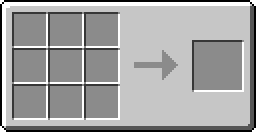Control Track
| Control Track | |
|---|---|
| File:Control Track.png | |
| Name | Control Track |
| Type | Rail |
| Tool | File:Grid Crowbar.png |
| Stackable | Yes (64) |
| Data Value | dec:206:3 |
| Mod Included | RailCraft |
The Control Track acts like a weak booster that only boosts Minecarts in one direction. Any carts travelling in the opposite direction will be gradually slowed. Powering them will reverse the direction of the track. They are cheap to make and will propagate power for up to sixteen blocks in either direction. The default direction can be changed with a Crowbar.
Recipe
Trivia
Control tracks were the third track implemented in RailCraft's early Alpha versions, and unlike the Boarding Rail and One-Way Rail that came before, the Control track suffered greatly from an incomplete design concept. Because of this they went through at least four radiacally different designs, the first being that they only boosted carts in one direction when powered by redstone. The ability to slow and reverse the carts direction was the next itteration. At this point redstone current was still required and they still had no name. The third itteration had them reverse directions on redstone current and it was this version that made it into release, though the texture sheet still possessed the unpowered textures until version 1.6.0. The name "Control Track" was chosen during a flash of insipiration shortly before v1.0.0 was released, prior to that the working name had been variations of "Slow-Booster" or "Booster-Brake" and was changed even more frequently than the rail's function. Surprisingly enough, the Control Rail eventually turned out to be one of the most useful rails included in Railcraft, thought they tend to get over-looked for the flashier rails. Verson 1.6.1 saw Control Rails undergo another significant change. The ability to change the facing of the rail with the crowbar. Prior to this, unpowered rails always faced a certain direction. While this was ok for general use of the rails, it became a limitation when attempting to use Control Rails in advanced settings that involve unrelated redstone currents activating the rails. After the change, simply powering the control track allows them to ignore any nearby changing redstone currents.




